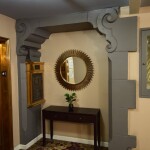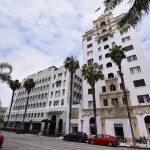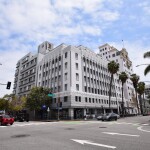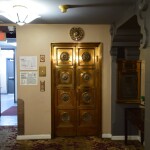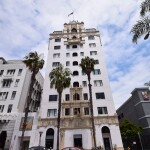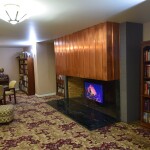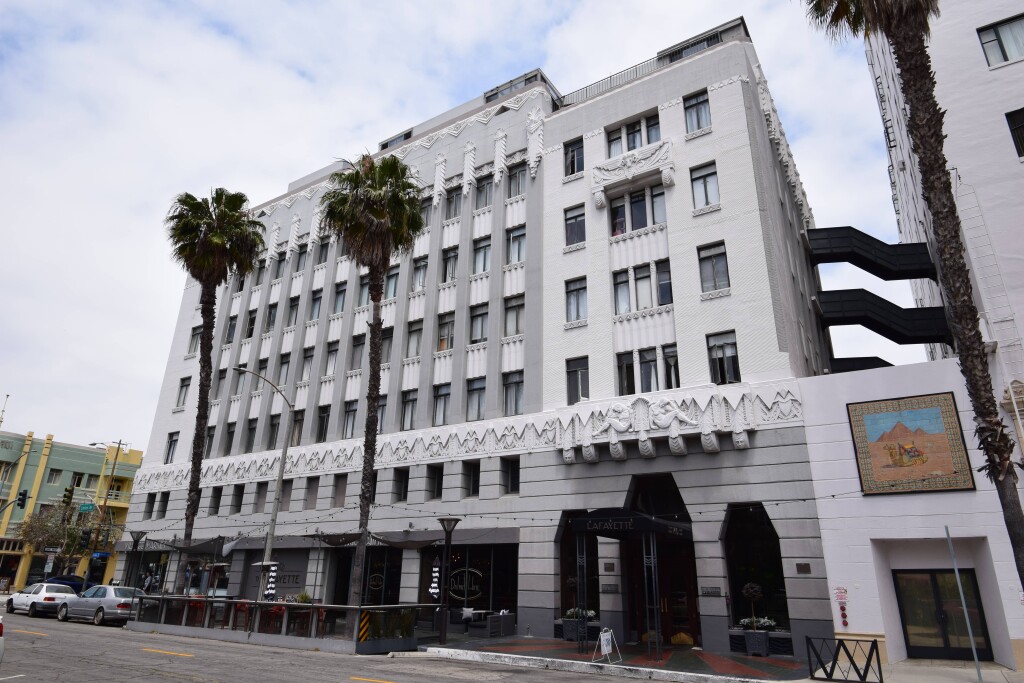
Explore the Lafayette Condos
An historic Long Beach condo in the East Village
Table of Contents
All About the Lafayette Condos
Walking into the Lafayette is a great experience, because you truly feel as though you are stepping back in time. It has an art-deco style common area and an elevator with a door that looks like it is made from solid gold. There are 173 condos to choose from here, although at any one point in time you will only find a couple of options to look at.
The Lafayette was constructed in 1928 with the original portion of the building being known as the Campbell Apartment Building and the “Lafayette Hotel” building was added just a year later to the north. With this rich history, and starting it’s life as apartments and a hotel you will find a variety of floor plans to choose from including: studios, 1 bedroom and 2 bedroom units. The sizes will range from under 400 sq ft to over 1,000 sq ft. The Lafayette hotel portion is 5 stories tall, while the Campbell building has 11 floors. Whether you are on the upper floors for your unit or enjoying the solarium you will have dramatic city views. Facing south you will get a mild peek to the ocean and see a great skyline. Over the years many of the units have been upgraded, but you will find that many took history into account with their upgrades. They bring modern convenience but use materials that would have been used during that era.
The former “Lafayette Hotel” is the building that is located to the north of the Campbell building.
Highlights
The Lafayette is a popular building in downtown. Some of the highlights of this historic building:
- Floor Plan Variety: Each condo is truly unique when it comes on the market. The sizes have a wide range and many have been expertly upgraded over the years.
- Prime Location: Being just a block and a half from Ocean Boulevard you have the opportunity to enjoy everything from fun outdoor activities to fine dining nearby.
- Extensive amenities including: Fitness room, billiard room, library and Solarium with one of the best views in Long Beach
Like most historic buildings the building has laundry facilities on site and parking is nearby in lots that you can rent on a monthly basis.
The Architects of the LaFayette1
With the tumultuous era of the late 1920’s and early 1930’s it isn’t surprising that buildings constructed this time have a rich history. Where condos were more rarely developed during that era, we get to enjoy condos that once served a different purpose. In the case of the Lafayette condo building in Long Beach it has a rich history as starting as apartments, having many additions over the years, and ultimately having three buildings combined to become what we now can enjoy as condos. With a history that is nearly 100 years in the making, it shouldn’t be surprising that this development had the hands of three different architects.
Parker O. Wright and Francis H. Gentry
The architects of Parker O. Wright and Francis H. Gentry designed 130 Linden, also known as the Campbell apartments. This 82 unit structure is the first building to make up the now named “Lafayette”. These architects combined their expertise to design the Campbell Apartments in the Spanish Baroque style.
Parker O. Wright
Parker O. Wright was born in 1893 in Iowa. He remained in the midwest for his early youth, including earning his architectural degree from the University of Illinois. One of the benefits of his time through the rigorous program at the University of Illinois is it gave him exposure to the emerging architectural trends of that era including the growing modernist movement.
While Parker began his career in the midwest, he didn’t wait long to make a move as he relocated to Long Beach, California in the early 1920’s. During that period in Long Beach (and the West Coast in general) there was a major building boom which gave him the opportunity to express his expertise and style to leave a lasting landmark on the city.
Francis H. Gentry
Francis H. Gentry was born in 1882 in Pennsylvania. During this period of industrial growth he showed an early interest in design and construction which eventually led him to pursue his formal education in architecture. He earned his degree in architecture from the University of Pennsylvania where he not only was influenced by the Beaux-Arts tradition but he also studied classical architecture and structural engineering.
Much like Parker O. Wright, he too noticed the burgeoning growth out west. He relocated to Long Beach, California where he had many notable projects, including the Campbell Apartments which features elements of Spanish Colonial revival and also incorporates Art Deco which can be seen in the geometric partners and modernist touches.
Arthur and Cecil Schilling
The brothers Arthur and Cecil Schilling are responsible for the design of 140 Linden, which was built after the Campbell apartments. Arthur was born in 1876 and Cecil was born in 1882. Both Arthur and Cecil attended the University of Pennsylvania’s School of Fine Arts. As was typical during that era they learned the principles of Beaux-Arts tradition which emphasized classical architecture, detailed craftsmanship and grandiose design (what a combination).
Like other architects during that period they recognized that Southern California represented one of the largest building opportunities. They moved to Long Beach in the early 1900’s. They embraced the Art Deco style, which embraces bold geometric patterns and that style is certainly evident when you walk through the doors of 140 Linden.
Ted Criley Jr.
It could be said that Ted Criley Jr. was destined for the field of architecture. Born in 1913 in California, his father was a well-known landscape architect and he embraced his father’s passion at an early age. He pursued his formal education in architecture at the University of Southern California (USC). USC’s architecture program has a long history of excellence where it is consistently ranked in the top 10 in the United States.
Ted Criley started his architectural career in the 1930’s when Southern California was still certainly in an era of building despite a slowdown from the great depression. His early work often involved collaborations; however, by the 1940’s he certainly had a larger amount of experience to tackle projects on his own. His contribution to what is now known as the Lafayette is the addition that was completed in 1948 along Broadway. This addition was carefully designed as part of the larger property and was done in the International Style.
Multiple Architects…for One Common Development
With the variety of architects involved over the years it really is a testament to forward thinking to see the building as it is today. The three separate buildings (Campbell Apartments, Lafayette Hotel, and the Annex Addition) were combined into a single hotel in 1952 when it was purchased and operated by Conrad Hilton.
Common Questions About the Lafayette Condos
The Lafayette is a condo development that can trace its origins back to 1928. With this rich history and now dominating a prime location in downtown Long Beach there are many questions we have been asked over the years about it. We invite you to discover more about this complex from the most common questions we have received.
What are the 3 buildings that make up the Lafayette condo development?
When you approach the Lafayette (140 Linden Ave) you may notice that there is a stairway connecting two buildings. This stairway connects the Campbell apartment house (the slender building that is located to the south) and the Lafayette hotel, which is the building to the north.
- Campbell Apartment House – This is the original 82 unit structure that is the founding building as part of the now known “Lafayette condos”
- Lafayette Hotel – The Lafayette Hotel is the building to the north of the Campbell Apartment house and was a 100 room hotel when it was launched in 1929.
- New Annex (1948 Broadway addition)
Is there parking at the Lafayette?
Parking is arranged via a lease program with the Marriott on First Street and Linden Avenue as the primary option. There is also a pay lot across the street as well that some residents use. When you are looking to become an owner here it would be best to speak to the office manager to understand your options.
When did the Lafayette become condos?
The Lafayette has a rich history, dating back to 1928; however it did not start it’s life as a condo complex, rather it started as the Campbell Apartment house. The Campbell Apartment Building is composed of 82 units. The Lafayette didn’t become condos until 1968, after hotel operations ceased in the year prior.
Is there inside laundry at the Lafayette?
There isn’t inside laundry in the individual condos; however, you will find laundry rooms
Are there any community amenities?
Being built in 1928 you might not think there would be amenities; however, this building has made changes over time to meet the needs of it’s residents. When you live here you will find you can enjoy a rooftop deck allowing you to enjoy beautiful views of downtown Long Beach, an outdoor area with BBQs, a solarium, a large gym with a variety of equipment, and even a library with a copper fireplace.
Does the Lafayette allow pets?
Pets are allowed with certain restrictions and there is a dog washing station.
What is included in the HOA?
As you look at the different condos for sale at the LaFayette you will notice that the HOA amount is different per unit. HOA’s can be calculated at the square footage of a unit which then results in a different HOA fee per unit. Take time to look at the unit you are interested in and the corresponding HOA dues. The HOA supports water, trash, and an on-site concierge.
The Lafayette Association of Homeowners has a great website with key forms, history, and much more.
What are the Architectural Styles of the Lafayette?
The Lafayette condo building is predominantly a combination of two architecture styles: Spanish Colonial Revival (the Campbell Building) and Art Deco (Lafayette Hotel). Understanding these two styles and how they are merged at 140 Linden can help you to understand if this is the right condo in Long Beach for you.
Spanish Colonial Revival Architecture
While there are a number of aspects that embody the Spanish Colonial Revival architecture style, the Campbell Building exudes a few key aspects that are worth noting.
- Stucco exteriors: You will see that the Campbell building features a stucco exterior, which provide a smooth and uniform finish which also helps to regulate temperature.
- Arched doorways and windows: Arches are a prominent architectural element, adding a sense of grandeur and sophistication to the design. As you face the Campbell building you will notice the middle section of windows are arched as well as the entrances on either side at the front of the building.
- Ornate detailing: Intricate detailing such as wrought iron balconies, decorative tiles, and carved woodwork are common features of this style, adding visual interest and texture to the façade. When you gaze up to the 9th floor you will see incredible details at the top of the building exuding the intricate detailing that Colonial Revival architecture is known for.
Art Deco Style of Architecture
The Art Deco style of architecture is characterized by rich colors, bold geometric shapes, and lavish ornamentation. Art Deco represented luxury, glamor, exuberance, and faith in social and technological progress. When you look at 140 Linden you will quickly recognize many of the aspects of the Art Deco style, in particular the following:
- Geometric Shapes and Symmetry: Art Deco architecture is known for its emphasis on geometric shapes and symmetry. Common motifs include zigzags, chevrons, sunbursts, and stylized floral patterns. These geometric forms often create a sense of movement and dynamism, reflecting the influence of Futurism and Cubism.
- Ornamentation and Decoration: While modernist movements like the Bauhaus advocated for minimalism and functionality, Art Deco embraced ornamentation. Buildings often feature intricate decorative elements such as friezes, bas-reliefs, and sculptures. These decorations are typically stylized and abstract, often incorporating motifs inspired by ancient civilizations. When you look at the main entrance of 140 Linden you can see the ornate decoration just above the first row of windows which makes you aware of the influence of the art deco style.
- Luxurious Materials: Art Deco architecture frequently employs luxurious materials such as marble, stainless steel, and inlaid wood. The use of these materials was intended to convey a sense of opulence and modernity. Glass and mirrors were also commonly used to enhance the sense of space and light. You will see a variety of these materials used at the Lafayette. With just a quick tour of the common areas and lobby you can find the use of copper, marble and fine wood details.
The art deco style is certainly engaging at 140 Linden Avenue and provides an excellent fluidity with the Spanish Colonial architecture of the Campbell building.
With the Lafayette embracing multiple architectural styles, it truly is a unique building in the landscape of available Long Beach condos.
The Lafayette’s Inaugural Year
Understanding the time period and events when a building was developed can help one to find an even greater appreciation for the building itself.
Amelia Earhart’s Transatlantic Flight:
In May 1928, Amelia Earhart became the first woman to fly across the Atlantic Ocean as a passenger on the Fokker F.VIIb/3m Friendship. Although she was not the pilot for this historic flight, it marked a significant achievement in aviation history and paved the way for her future accomplishments as a pioneering aviator.
Mickey Mouse’s Debut:
On November 18, 1928, Mickey Mouse made his debut in the animated short film “Steamboat Willie,” which premiered at the Colony Theatre in New York City. Created by Walt Disney and Ub Iwerks, Mickey Mouse would go on to become one of the most iconic and beloved characters in the world.
The First Transatlantic Telephone Call:
In January 1928, the first transatlantic telephone call was made between New York City and London. This historic event demonstrated the growing interconnectedness of the world and marked a milestone in telecommunications technology.
From a transatlantic call, a transatlantic flight, to a beloved animated character hitting the big screen, 1928 was a momentous year. Along with those major historical events the Lafayette (Campbell Building) made it’s debut in Long Beach, etching itself into the history books of this great city.
Dining Options
When you select a place to live, you aren’t just there to sleep….you generally want to have great places to eat nearby. With the Lafayette occupying a prime location in the East Village Arts district of downtown Long Beach you won’t be disappointed with the volume of options for dining. We have highlighted a few of our favorites that you could enjoy.
- The Attic: It is situated in a 1920’s Craftsman style home and is known for its creative twists on Southern comfort food, The Attic offers a cozy atmosphere and a menu featuring dishes like macaroni and Cheetos and fried chicken and waffles.
- Michael’s Pizzeria: Serving authentic Neapolitan-style pizzas made with fresh ingredients and cooked in a wood-fired oven. Michael’s uses locally sourced ingredients in all of their food which, besides pizza, includes hand-made pasta, salads, and grain bowls. It is located nearby at 210 E. 3rd.
- The Sky Room: This restaurant is worth noting as it is located on the 15th floor of the historic Breakers Building, The Sky Room offers breathtaking views of Long Beach and the Pacific Ocean, along with a menu of upscale cuisine and live music. Its history dates back to 1938 and while it is under renovation until Fall of 2024 it should certainly be on your list for fine dining in downtown Long Beach.
One of the exciting parts about living in downtown Long Beach is the array of restaurants available. Take time to explore the many great options and see which culinary classics you will enjoy regularly when you call this place home.
Activities and Attractions
Downtown Long Beach is a vibrant location. One of the exciting parts about calling the Lafayette home is that you have many different activities and attractions to enjoy year round. While of course you can enjoy the larger events such as the annual Long Beach Grand Prix or the iconic Long Beach Aquarium we thought it is worth noting a few of the other great options you can enjoy when you reside in the East Village Arts District.
- Long Beach Art Walk: On the second Saturday of every month there is an art walk in the East Village Arts District. The Long Beach Art Walk is a free, monthly event that showcases the work of local artists in galleries, studios, and public spaces throughout the East Village Arts District. The event features live music, performances, and opportunities to meet the artists. It’s an excellent way to experience the creative spirit of Long Beach while enjoying the vibrant atmosphere of the downtown area.
- Long Beach Farmers Market: While there are a few Farmers markets in Long Beach, the one that is closest to the Lafayette is the one located at Marina Green Park, 386 E. Shoreline Drive. This Farmers Market is open on Fridays from 10am to 2pm. It offers fresh produce, artisanal foods, and handcrafted goods from local vendors. It’s a great place to find organic fruits and vegetables, freshly baked bread, flowers, and gourmet products. The market also features live music and food stalls, creating a festive atmosphere for shoppers.
- Rainbow Harbor and Marina: Rainbow Harbor and Marina is a picturesque waterfront area that offers recreational boating, dining, and scenic views. Visitors can enjoy a leisurely walk along the harbor, rent boats, or take a harbor cruise. The area also features several waterfront restaurants and bars, providing a perfect spot to relax and enjoy the coastal ambiance.
There are of course many other options to enjoy nearby such as the Pike Outlets, Shoreline Village and much more. When you reside here you won’t have any shortage of fun to enjoy.
Historic Designation
The City of Long Beach2 recognizes over 100 landmarks throughout the city. One objective of identifying landmarks as historic via municipal code is to protect the architectural value that these properties offer to the community. Many of the details that these properties embrace simply could not be done today to the expensive nature and ever restrictive building codes. 130-140 Linden is designated historic by the City of Long Beach and it is known as the Lafayette Complex.
Interested in Buying a Condo or Selling Your Condo at the Lafayette?
When you are interested in selling your Lafayette condo (or buying) there are many items to consider. Regardless of whether you are selling or buying it is about understanding market conditions, the individual condo at the Lafayette, upgrades/conditions, your goals, and even more. Lafayette condos occupy a unique part in the landscape of Long Beach Condos and getting the most from a sale or the best price on a purchase is about having the right real estate agent/broker to help you. When you would like guidance, whether you are buying or selling please fill out our Long Beach Hot List and we will be happy to help.
Photos of the Lafayette Condos
Explore more about the Lafayette Condos from the Campbell Apartments portion to the Annex and even details of the interior.
Additional Resources:
- History of the Lafayette
- 1Architects of the Lafayette
- 2List of Historic Landmarks by the City of Long Beach
- HOA Contact Information:
- Lafayette Association of Homeowners, Inc; (562)436-5391
